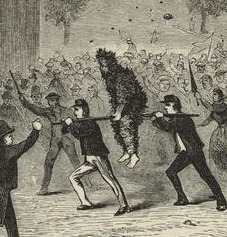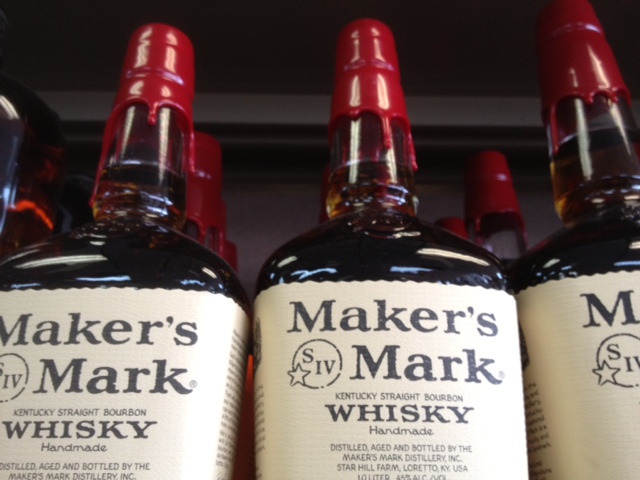The Digital Whiskey Rebellion, Or How Maker’s Returned To The Mark
I was proofreading a piece on Richard III for the second time when the folks at Maker’s Mark® announced a little re-proofing of their own. Much to their surprise, they incited a Whiskey Rebellion worthy of 1791. If eighteenth-century Americans had preferred Twitter® and Facebook® to tar and feathers, that is.
 You probably heard about the Whiskey Rebellion in high school. You may even confuse it with the Fake ID Citation or the Raid On Dad’s Beer Fridge. To clarify, the Whiskey Rebellion was the first true test of the power of the federal government. In an effort to pay off debts accumulated during the revolutionary war, newly minted Treasury Secretary Alexander Hamilton pushed a tax on whiskey producers through congress. An angry public pushed back, particularly in Pennsylvania.
You probably heard about the Whiskey Rebellion in high school. You may even confuse it with the Fake ID Citation or the Raid On Dad’s Beer Fridge. To clarify, the Whiskey Rebellion was the first true test of the power of the federal government. In an effort to pay off debts accumulated during the revolutionary war, newly minted Treasury Secretary Alexander Hamilton pushed a tax on whiskey producers through congress. An angry public pushed back, particularly in Pennsylvania.
Having won their freedom from arbitrary English taxes, our forefathers were far from eager to pony up. Transforming grain into whiskey was one of the few ways to store harvests in those days; trading in it was seen as a birthright. What’s more, many felt Hamilton’s tax unfairly favored large producers over small farmers operating their own stills.
 As often happens when large amounts of booze are involved, things got ugly fast. In 1791, “whiskey rebels” tarred and feathered a tax inspector and a process server. By 1794, shots were being exchanged, a rebel leader was killed, a tax inspector’s home was torched and armed mobs were threatening Pittsburgh.
As often happens when large amounts of booze are involved, things got ugly fast. In 1791, “whiskey rebels” tarred and feathered a tax inspector and a process server. By 1794, shots were being exchanged, a rebel leader was killed, a tax inspector’s home was torched and armed mobs were threatening Pittsburgh.
Hamilton pushed for military intervention. President Washington chose negotiation. When talks failed, Hamilton got his way, and 13,000 troops marched into the Keystone State. The rebellion evaporated. Hamilton was elated. Jefferson was appalled. George Washington served two terms and returned to Mount Vernon, earning a living by–wait for it–distilling whiskey.
You probably heard about the Whiskey Rebellion of 2013 from the instantaneous, inescapable consumer outrage. It’s a textbook lesson in the power of social media. One that leaves no remaining doubts about customers’ ability to clobber companies that dare to mess with beloved brands.

The seeds of rebellion were sown when Maker’s Mark announced that they were lowering the proof of their flagship bourbon from 90% to 84%. The stated reason was simple enough: they had underestimated demand. Bourbon sales were booming at home and abroad, and Maker’s Mark was struggling with a product shortage. Because bourbon is aged in barrels for years before bottling, increasing production couldn’t solve the immediate problem. The company had a choice. Let some customers go without, or add more water to the current stock, reducing the proof and stretching supplies. They chose the latter.
Of course, almost all whiskey is cut with water between the barrel and the bottle. This helps the distiller create a specific taste (flavor profile) and consistent alcohol content (proof). There are a few barrel proof bourbons available. But they are far too potent and pricey for most consumers.
Bill Samuels, Chairman Emeritus of Maker’s Mark, explained the lower proof in levelheaded terms. The company had been very careful to craft a new Maker’s Mark that hewed to the existing flavor profile. He could not detect any difference in taste, and he did not believe other drinkers would, either. Loyal customers would not go without. The retail price would remain the same.
All was well. Until all hell broke loose.
(This concludes Part I. Click here to read The Digital Whiskey Rebellion Part II.)
Larry McC.
Maker’s Mark executives should have known that bourbon sales would continue to rise exponentially, in lock-step with all the dismal news about Washington gridlock, sequesters, and Tennessee Titans football. Oh yeah, and Univesity of Kentucky basketball. I bet their fans are reachin’ for the bourbon.
Tim M.
Interesting choice of words when you wrote, “By 1794, shots were being exchanged…” Oh, you meant with guns! One could argue that Maker’s Mark just pulled off a great marketing ploy, creating outrage to get consumers buying up the 90 proof. Or we could add this blunder to another great goof-up, the changing of the Coke formula. Hey, I got it! Coke buys Maker’s Mark and they produce Whisky & Coke six packs. Now that’s a marketing plan!
Beaumont F.
Your style is so unique in comparison to other folks I’ve read stuff from. I appreciate you for posting when you have the opportunity. Guess I’ll bookmark this site.
Doyle Santory
Thanks , I’ve just been searching for info about this topic for ages and yours is the best I have came upon till now. I guess we’ll eventually find out if it’s really bottom line or supply.